The Hickson Compact Group of Galaxies
Arp's Catalog Of Peculiar Galaxies
The following page not only offers images of elliptical galaxies but astronomical data from many sources including,
The Hickson Compact Group of Galaxies by Paul Hickson ( 1982 ) and
Arp's Catalog Of Peculiar Galaxies by Halton Arp ( 1966 ). Both of these sources list, amongst others, elliptical galaxies and I am indebted to NASA/IPAC Extragalactic Database ( NED ) which is operated by the Jet Propulsion Laboratory, California Institute of Technology, under contract with the National Aeronautics and Space Administration for the online publication of research work contained within these catalogs. Additional astronomical data for stellar objects is from either the Simbad Data Query site or the HEASARC Data Archive.
Hickson's HCG's
HCG 92 — Stephan's Quintet
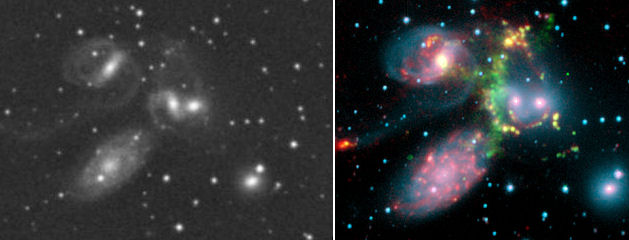
"
As their name suggests, compact groups are small systems of several galaxies in a compact configuration on the sky. The first example was found over one hundred years ago by [Édouard] Stephan ( 1877 ) who observed it visually using the 80-cm Foucault telescope of the Observatoire de Marseille" — Paul Hickson [12] While much of the fame has gone to the plethora of beautiful images that have been displayed in popular media the world over, there is a wealth of lesser known stellar objects that are just as breathtaking; their titanic interactions emmense beyond belief. At right are two images of Stephan's Quintet also known as HCG 92a, HCG 92b, HCG 92c, HCG 92d and HCG 92e. In the left frame is a section of the original 12.9' x 12.9' image from the
Palomar Observatory Sky Survey ( POSSII ). The colorful image in the right frame is a "false-color composite image of the Stephan's Quintet galaxy cluster [which] clearly shows one of the largest shock waves ever seen ( green arc ), produced by one galaxy falling toward another at over a million miles per hour." [13] The image composite is made up of three data sets taken at the various wavelenghts of light — near-infrared light ( blue ) and visible light called H-alpha ( green ) from the
Calar Alto Observatory in Spain, operated by the
Max Planck Institute in Germany and 8-micron infrared light ( red ) from
Spitzer's infrared array camera. "Four of the five galaxies in this image are involved in a violent collision, which has already stripped most of the hydrogen gas from the interiors of the galaxies. The centers of the galaxies appear as bright yellow-pink knots inside a blue haze of stars, and the galaxy producing all the turmoil, NGC7318b, is the left of two small bright regions in the middle right of the image." [Ibid] The elliptical galaxy HCG 92e is at lower right in the above images.
In the HCG catalog is a section on studies conducted with regard to the structure and morphology of various compact groups in which elliptical galaxies are included ( see
5.2 Compact-group galaxies ). Though outside the scope of this page, Hickson asked, "Are the galaxies in compact groups in any way distinct from those in their immediate environments?
Rood & Williams (1989) and
Kindl (1990) both found that compact groups, including those in rich environments, contain a significantly smaller fraction of late-type ( spiral and irregular ) galaxies than do their neighborhoods." Remembering our previous discussion regarding the formation process of elliptical galaxies, we can perhaps see one of the reason why they are found commonly within multiple systems as the above or foregoing images illustrate.
HCG 90 — NGC 7173, 7174 and 7176
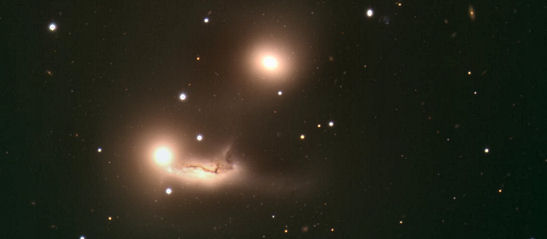
"Colour composite image of a triplet of galaxies which make up part of the Hickson Compact Group HCG 90. The galaxies in the image are NGC 7173 ( top ), NGC 7174 ( lower left ) and NGC 7176 ( lower right ), the size of the image is about 5.3 arcminutes. The image is based on data obtained with the VLT FORS1 with B, V, and R filters. NGC 7173 and 7176 are elliptical galaxies, while NGC 7174 is a spiral galaxy with a

disturbed dust lane." Image and text from the
ESO Website The European Homepage for the NASA/ESA Hubble Space telescope has a nice short video presentation which pans over these galaxies; in Mpeg or Quicktime formats. Click the filmstrip >>
Astronomical Data for Above:
Stephan's Quintet is a group of galaxies located at RA: 22 35 57.5 Dec: +33 57 36 with a radial velocity,redshift of 6291 km/s,z 0.021208. Known other names or identifiers include HCG 92, Stephan's Quartet, RSCG 82, RX J2236.0+3358.
NGC 7173 is a galaxy located at RA: 22 02 03.38 Dec: -31 58 26.9 with a radial velocity/redshift of 2684 km/s. It has a morphological type of E and a angular size of ( arcmin ) 1.380 0.954 143. Known other names or identifiers include ESO 466-39, HCG 90c, LEDA 67878 and 2MASX J22020320-3158253.
NGC 7174 is a galaxy located at RA: 22 02 06.82 Dec: -31 59 36.5 with a radial velocity/redshift of 2659 km/s. It has a listed morphological type of Im ( irregular ) and a angular size of ( arcmin ) 1.584 0.758 88. Other names include ESO 466-40, HCG 90d, LEDA 67881 and SGC 215912-3214.0.
NGC 7176 is a galaxy located at RA: 22 02 08.45 Dec: -31 59 29.5 with a radial velocity/redshift of 2585 km/s. It has a morphological type of E and a angular size of 1.230 1.047. Known other names or identifiers include ESO 466-41, HCG 90b, LEDA 67883, 2MASX J22020846-3159233.
Reference data obtained from the Simbad script utility: C.D.S. - SIMBAD4 rel 1.119 - 2009.04.18CEST21:29:11
HCG 87
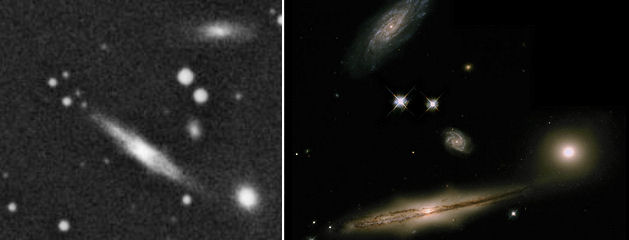
Hickson Compact Group 87 photographed by the Hubble Space Telescope
Courtesy NASA/STScI/AURA "Posing for this cosmic family photo are the galaxies of HCG ( Hickson Compact Group ) 87, about four hundred million light-years distant toward the amphibious constellation Capricornus. The large edge-on spiral near picture center, the fuzzy elliptical galaxy immediately to its right, and the spiral near the top of the image are identified members of the group, while the small spiral galaxy in the middle is likely a more distant background galaxy. In any event, a careful examination of the deep image reveals other galaxies which certainly lie far beyond HCG 87. While not exactly locked in a group hug, the HCG 87 galaxies are interacting gravitationally, influencing their fellow group members' structure and evolution."
APOD The image shown at the Astronomy Picture of the Day website ( 'APOD' link ) is almost a dupilcate of the one taken by GMOS-S Commissioning Team for the commissioning phase of an instrument on the
Gemini Observatory's South Telescope at Cerro Pachon, Chile. The elliptical galaxy seen at mid-lower right is designated as an SO type, right at the branch in Hubbles tuning fork diagram, and is known by the identifier MCG-03-53-003 or LEDA 65409. The image in the left frame, obtained from the
Aladin previewer website, is a European Southern Observatory Survey image digitized at the MAMA facility in Paris.
HCG 40
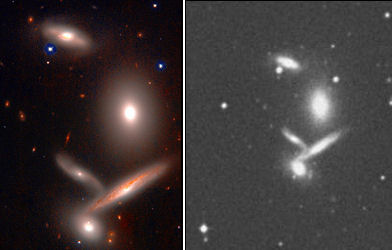
"Galaxies, like stars, frequently form groups. A group of galaxies is a system containing more than two galaxies but less than the tens or hundreds typically found in a cluster of galaxies. A most notable example is the Local Group of Galaxies, which houses over 30 galaxies including our Milky Way, Andromeda, and the Magellanic Clouds. Pictured [left] is nearby compact group Hickson 40. This group is located about 300 million light-years away toward the constellation of Hydra. Of the five prominent galaxies in Hickson 40, three are spirals, one is an elliptical and one is a lenticular. Many galaxies in compact groups are either slowly merging or gravitationally pulling each other apart."
APOD Credit: CISCO, Subaru 8.3-m Telescope,
NAOJ. The elliptical galaxy is known as HCG 40f (
Simbad ). At the
Adventures in Deep Space website, HCG 40 is just one of 99 Hickson's group of galaxies on their viewing list. Says the website's head observing expert, Steve Gottlieb:
"Hickson 40A is the brightest and first of four in the compact group Hickson 40 = Arp 321 = VV 116 group. Very faint, very small, round. Also in the group are Hick 40D = M-01-25-012 55" NE, Hick 40B = M-01-25-010 1.1' SSE and Hick 40C = M-01-25-008 40" S. Hickson 40C is an elongated threshold object glimpsed intermittently just N of Hickson 40B. At first, this pair was not resolved and I was not sure if I was viewing a single compact or elongated gx, but was gradually convinced that two distinct galaxies were visible. Located just 40" S of the center of Hickson 40A and 30" NW of Hickson 40B.Hickson 40B appears very faint, extremely small, round. At times, appears elongated or a fainter companion system is attached at the N side ( this is Hick 40C ). Hickson 40D appears very faint, small, elongated 3:2 E-W. This is the second easiest ( of 4 ) in an interesting tight group. A mag 14 star lies2.3' NW." [14]
Astronomical Data for Above & Below:
HCG 87 is a group of 4 galaxies located at RA: 20 48 11.9 Dec: -19 50 26 with a galactic Latitude and Longitude ( degrees ) of -34.2671, 26.4789. The brightest member of this group has a red magnitude of 12.9 ( total group magnitude of 12.4 ) and a classification of S1 for the group. [15]
HCG 40 is a group of 6 galaxies located at RA: 09 38 54.5 Dec: -04 51 07 with a galactic Latitude and Longitude ( degrees ) of 33.5932, 239.9587. The brightest member of this group has a red magnitude of 12.5 ( total group magnitude of 11.4 ) and a classification of E2 for the group. [16]
M84 is a Seyfert 2 Galaxy located at RA: 12 25 03.74333 Dec: +12 53 13.1393 with a Radial Velocity/Redshift( r ) of 1008 km/s ( r ) z 0.003369 it has a morphological type of E* with an angular size of ( arcmin ) 6.025 5.370 135. Known other names and identifiers include LEDA 40455, NGC 4374, OHIO A 322, UGC 7494 and 2MASX J12250377+1253130. *Recent scientific evidence has some astronomers moving M84 to a type S0 Lenticular galaxy. [17]
Messier 84
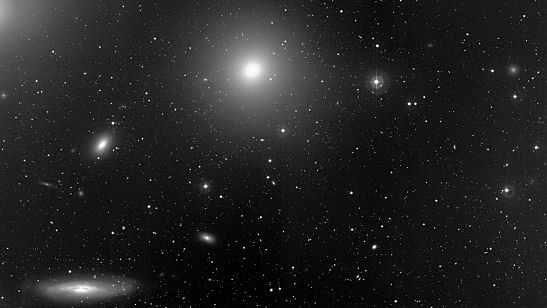
"Sky field near some of the brighter galaxies in the Virgo Cluster. This image was obtained in April 2000 with the Wide Field Imager ( WFI ) at the La Silla Observatory. The large elliptical galaxy at the centre is Messier 84; the elongated image of NGC 4388 ( an active spiral galaxy, seen from the side ) is in the lower left corner. The field measures 16.9 x 15.7 square arcmin." Image & text from the ESO website
Bright Galaxies in the Virgo Cluster M84 was discovered by Charles Messier ( 1730 — 1817 ) on March 18, 1781, a date on which he also cataloged seven other nebulous objects in the same region of sky. Though little is known about him prior to his joining the Paris Observatory he is credited with 15 original and 6 co-discovered comets as well as he very famous catalogue, which he began in 1760, taking more than twenty years to compile. [18] Though it is still listed as an elliptical galaxy, M84 has recently begun to be described by astronomers as a Lenticular ( S0 ) type of galaxy, an intermediate type between ellipticals and spirals that sits right at the middle branch in Hubble's tuning fork diagram.
A Black Hole in M84
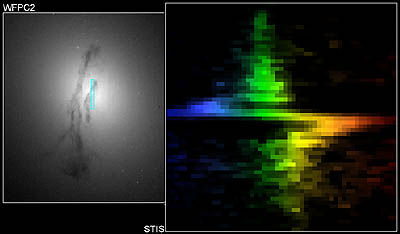
Another notable fact about galaxy M84 is that it has been the center of scientific investigations into the area of black hole science. While black holes will eventually be covered in another section of this site

a brief video journey from the
Chandra X-Ray Observatory website will help explain the science behind these unseen objects within our universe. The video is well done and informitive but will require you to have the
Quicktime plug-in or compatible player installed for your browser ( the link will take you to the Quicktime OEM download page ). << Click on the film strip to watch the movie about black holes from the Chandra website. The image at right is from a May 12, 1997 news release from the HubbleSite - NewsCenter, "The colorful "zigzag" on the right is not the work of a flamboyant artist, but the signature of a super-massive black hole in the center of galaxy M84, discovered by the Hubble telescope's imaging spectrograph. The image on the left [frame], also taken by Hubble, shows the core of the galaxy where the suspected black hole dwells. In a single exposure, astronomers mapped the motions of gas in the grip of the black hole's powerful gravitational pull by aligning Hubble's spectroscopic slit across the nucleus." [19]
Arp's Peculiars — Tidal Tails & Bridges
Arp 107 Star Formation From Interaction
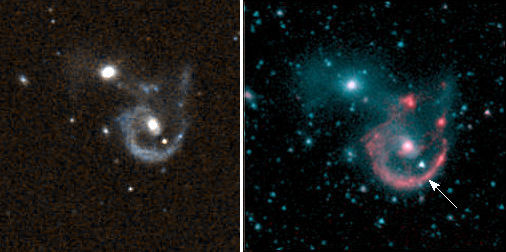
A peculiar pair of colliding galaxies, comprised of a Spiral type c and an Elliptical and known as Arp 107, are shown in the image at left. In the left frame is an image from the Aladin previewer obtained from the Palomar Observatory Sky Survey ( POSSII, Red, G avg, Blue ) The second image is from the
Spitzer Space Telescope website, taken with the IRAC ( the Infrared Array Camera ) and is a composite of multi-wavelength images comprised of red=8.0 microns and blue=3.6 microns which mapped the faint regions of new star formation - younger stars are mapped at 8.0 microns ( red ) and older stars are mapped at 3.6 microns ( blue ). The two wavelength mappings are then combined to produce a single image showing astronomers the comparative areas of stellar formation and age in the outer tidal ( arrow ) arm of Arp 107.
The scientific results from this mapping are seen in the image at right.
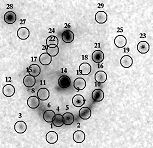
In science surveys, the search for star forming regions is always primary to the researcher of stellar evolution and Arp 107 is no exception: "We present Spitzer infrared imaging of the peculiar galaxy pair Arp 107 and compare with an optical H

map and a numerical model of the interaction. The [3.6

] - [4.5

] colors of clumps in the galaxy do not vary around the ringlike primary spiral arm and are consistent with those of stars; thus, these bands are dominated by starlight. In contrast, the [5.8

] - [8.0

] colors are consistent with those of interstellar dust and vary by about 0.2 mag around the ring/spiral, with redder colors associated with regions with stronger star formation as indicated by H

and mid-infrared luminosity. The [4.5

] - [5.8

] colors for clumps in this arm are bluer than dust and redder than stars and vary by 1.3 mag around the arm. This color is therefore a measure of the relative number of young stars to old stars, with a redder color indicating a higher proportion of young stars" (
Astronomical Journal 2005, Smith et. al. ) The circles at right identify the clumps of star forming regions as indicated by the survey team, identify young and old stellar populations, mapping their distribution within the stellar material. [20] One of the goals of the research team was to "
resolve the nature of this collisional system and to better understand the structure of the star formation in the arm, we have attempted to numerically model it. Given that we have limited kinematical information and very little information on the gas distribution, we have not attempted to model it in great detail but rather to produce a reasonable preliminary model." Their model however, did show promise as it indicated reasons for the structural formation of star populations seen in the outer arm of Arp 107 and concluded, in part that their "
example suggests bright prospects for learning about star formation mechanisms by comparing Spitzer data to models of interacting galaxies." [Ibid]
Arp 94 — The Liner & The Seyfert
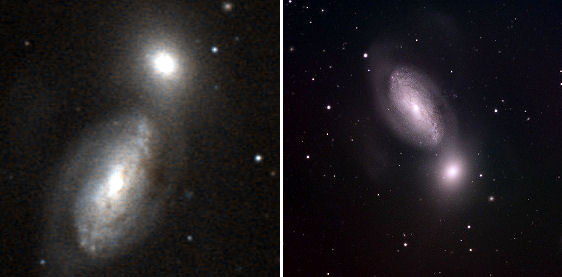
The word "Liner" is actually a scientific acronym for
Low-
Ionization
Nuclear
Emission-line
Region. Liners are a type of active galaxy which are characterized by their very bright almost starlike central nuclei. They are similar to their stellar cousins, the Seyfert galaxies, except for their lower luminosity. The
Seyfert is a type of spiral galaxy with a small, compact and bright nucleus that exhibits variable light intensity and radio-wave emissions as a result of extremely ionized gases. They have been named after Carl Keenan Seyfert, the astronomer who first identified the class in 1943 ( at Mount Wilson in California ) and published a paper on "galaxies with bright nuclei that emit light with emission line spectra with characteristically broadened emission lines. The prototype example is Messier 77 ( NGC 1068 )" These two galaxies were orignially discovered by the German born British astronomer and composer
Sir Frederick William Herschel in 1784 [21] Image credits: ( l )
Simbad ( r )
Sid Leach, Wil Milan and Adam Block taken at the
Kitt Peak Observatory ( KPNO )
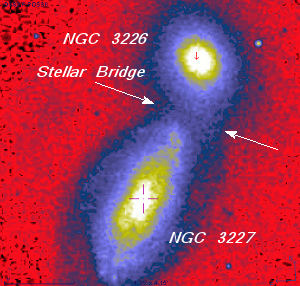
The galaxies in Arp 94 ( also known as NGC 3226 & 3227 ) are interacting in such a way as to form a bridge or lane of stellar gas and dust between themselves which is clearly illustrated in the image at right, obtained from the
Aladin Sky Atlas ( DSS2.F.POSSII )
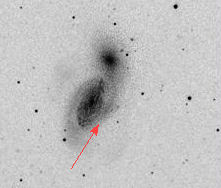
At left is a negative and enhanced image ( source: K. Pinkela ) of Arp 94 which also shows a lane or tidal arm, connecting the ( red arrow ) sprial galaxy to the elliptical galaxy. In terms of astronomical science, the concusions of a 1993 astrophysics review are as relevant today, in 2009, as they were when written: "
In the last two decades the concepts of galaxies as "island universes" that are slowly evolving virtually in total isolation have changed considerably. It turned out that gravational interaction between galaxies is one of the main factors in their evolution, capable of altering such fundamental characteristics of galaxies as morphological type, luminosity, size and mass distribution. Two of the most intriguing (and therefore most intensly studied) processes — star formation and the activity of galactic nuclei — also turned out to be associated with the interaction between galaxies." ( Reshetnikov & Sotnikova 1993 ) [22]
Arp 97
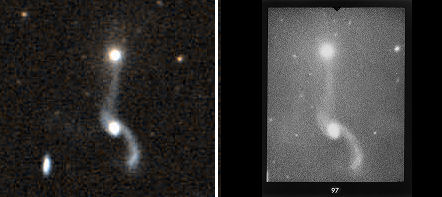
At left (left-frame) is an RGB image ( POSSII/F/DSS2 red, green avg, POSSII/J/DSS2 blue ) of Arp 97 from the Aladin previewer. Seen in the right-frame is ARP 97, the original from Halton Arp's catalog. This is a negitive of the original obtained from the
NASA/IPAC Extragalactic Database from their posting of the
Atlas of Peculiar Galaxies Mr. Arp wrote of the ordering scheme of galaxies within his catalog, "
Because so many of the physical processes pictured are not understood, no rigorous attempt at classification has been made. The galaxies have been grouped empirically, putting together all the objects that look alike. Special emphasis is on the form of the galaxies or the nature of the peculiarity and the gradual change of the peculiarity from object to object." The small black notch seen at the top of the image indicates north. [23]
Astronomical Data for Above:
Arp 107 is a group of two galaxies located at RA: 10 52 14.96 Dec: +30 03 28.2 with a galactic Latitude and Longitude ( degrees ) of 199.4284 +63.7473 and a Radial velocity / Redshift ( r ) of 9946 km/s (r ) z 0.033745. It's morphological type is Sc + E with an angular size of ( arcmin ) 2.511 1.949. Known other names and identifiers include MCG+05-26-024, LEDA 32620, UGC 5984, VV 233
Arp 94 is a group of two galaxies located at RA: 10 23 27.08 Dec: +19 53 54.5 with a galactic Latitude and Longitude ( degrees ) of 216.9278 +55.4434 and Radial velocity / redshift ( r ) of 1266 km/s ( r ) z 0.00423/cz 1269.0. It's morphological type is dE with an angular size of ( arcmin ) 2.630 2.344 15. Known other names and identifiers include NGC 3226, LEDA 30440, MCG+03-27-015, UGC 5617, VV 209b
Arp 97 is a group of two galaxies located at RA: 12 05 45.6 Dec: +31 03 30 with a galactic Latitude and Longitude ( degrees ) of 188.7186 +79.2824 and a Radial velocity / Redshift ( r ) of km/s 6830 ( r ) z 0.023049/cz 6909.92. It's morphological type is S0a with an angular size of ( arcmin ) 2.454 0.724. Known other names and identifiers include VV 13, DOC NRGb181.7, LEDA 38325, MCG+05-29-010, UGC 7085 A [24]
Final Images — Ellipticals
NGC 1316
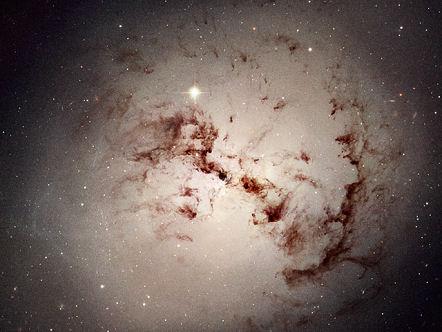
This image is from the
Astronomy Picture of the Day website: "Astronomers turn detectives when trying to figure out the cause of startling sights like NGC 1316. Their investigation indicates that NGC 1316 is an enormous elliptical galaxy that started, about 100 million years ago, to devour a smaller spiral galaxy neighbor, NGC 1317, just above it. Supporting evidence includes the dark dust lanes characteristic of a spiral galaxy, and faint swirls of stars and gas visible in this wide and deep image. What remains unexplained are the unusually small globular star clusters, seen as faint dots on the image. Most elliptical
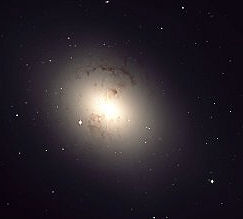
galaxies have more and brighter globular clusters than NGC 1316. Yet the observed globulars are too old to have been created by the recent spiral collision. One hypothesis is that these globulars survive from an even earlier galaxy that was subsumed into NGC 1316."
Credit: P. Goudfrooij (STScI), Hubble Heritage Team, (STScI/AURA), ESA, NASA At right is another image of NGC 1316 from the
ESO website and the HubbleSite NewsCenter also has a scientific page on this elliptical galaxy:
Hubble Finds More Evidence of Galactic Cannibalism
 "As their name suggests, compact groups are small systems of several galaxies in a compact configuration on the sky. The first example was found over one hundred years ago by [Édouard] Stephan ( 1877 ) who observed it visually using the 80-cm Foucault telescope of the Observatoire de Marseille" — Paul Hickson [12] While much of the fame has gone to the plethora of beautiful images that have been displayed in popular media the world over, there is a wealth of lesser known stellar objects that are just as breathtaking; their titanic interactions emmense beyond belief. At right are two images of Stephan's Quintet also known as HCG 92a, HCG 92b, HCG 92c, HCG 92d and HCG 92e. In the left frame is a section of the original 12.9' x 12.9' image from the
"As their name suggests, compact groups are small systems of several galaxies in a compact configuration on the sky. The first example was found over one hundred years ago by [Édouard] Stephan ( 1877 ) who observed it visually using the 80-cm Foucault telescope of the Observatoire de Marseille" — Paul Hickson [12] While much of the fame has gone to the plethora of beautiful images that have been displayed in popular media the world over, there is a wealth of lesser known stellar objects that are just as breathtaking; their titanic interactions emmense beyond belief. At right are two images of Stephan's Quintet also known as HCG 92a, HCG 92b, HCG 92c, HCG 92d and HCG 92e. In the left frame is a section of the original 12.9' x 12.9' image from the  "Colour composite image of a triplet of galaxies which make up part of the Hickson Compact Group HCG 90. The galaxies in the image are NGC 7173 ( top ), NGC 7174 ( lower left ) and NGC 7176 ( lower right ), the size of the image is about 5.3 arcminutes. The image is based on data obtained with the VLT FORS1 with B, V, and R filters. NGC 7173 and 7176 are elliptical galaxies, while NGC 7174 is a spiral galaxy with a
"Colour composite image of a triplet of galaxies which make up part of the Hickson Compact Group HCG 90. The galaxies in the image are NGC 7173 ( top ), NGC 7174 ( lower left ) and NGC 7176 ( lower right ), the size of the image is about 5.3 arcminutes. The image is based on data obtained with the VLT FORS1 with B, V, and R filters. NGC 7173 and 7176 are elliptical galaxies, while NGC 7174 is a spiral galaxy with a 
 Hickson Compact Group 87 photographed by the Hubble Space Telescope
Courtesy NASA/STScI/AURA "Posing for this cosmic family photo are the galaxies of HCG ( Hickson Compact Group ) 87, about four hundred million light-years distant toward the amphibious constellation Capricornus. The large edge-on spiral near picture center, the fuzzy elliptical galaxy immediately to its right, and the spiral near the top of the image are identified members of the group, while the small spiral galaxy in the middle is likely a more distant background galaxy. In any event, a careful examination of the deep image reveals other galaxies which certainly lie far beyond HCG 87. While not exactly locked in a group hug, the HCG 87 galaxies are interacting gravitationally, influencing their fellow group members' structure and evolution."
Hickson Compact Group 87 photographed by the Hubble Space Telescope
Courtesy NASA/STScI/AURA "Posing for this cosmic family photo are the galaxies of HCG ( Hickson Compact Group ) 87, about four hundred million light-years distant toward the amphibious constellation Capricornus. The large edge-on spiral near picture center, the fuzzy elliptical galaxy immediately to its right, and the spiral near the top of the image are identified members of the group, while the small spiral galaxy in the middle is likely a more distant background galaxy. In any event, a careful examination of the deep image reveals other galaxies which certainly lie far beyond HCG 87. While not exactly locked in a group hug, the HCG 87 galaxies are interacting gravitationally, influencing their fellow group members' structure and evolution."  "Galaxies, like stars, frequently form groups. A group of galaxies is a system containing more than two galaxies but less than the tens or hundreds typically found in a cluster of galaxies. A most notable example is the Local Group of Galaxies, which houses over 30 galaxies including our Milky Way, Andromeda, and the Magellanic Clouds. Pictured [left] is nearby compact group Hickson 40. This group is located about 300 million light-years away toward the constellation of Hydra. Of the five prominent galaxies in Hickson 40, three are spirals, one is an elliptical and one is a lenticular. Many galaxies in compact groups are either slowly merging or gravitationally pulling each other apart."
"Galaxies, like stars, frequently form groups. A group of galaxies is a system containing more than two galaxies but less than the tens or hundreds typically found in a cluster of galaxies. A most notable example is the Local Group of Galaxies, which houses over 30 galaxies including our Milky Way, Andromeda, and the Magellanic Clouds. Pictured [left] is nearby compact group Hickson 40. This group is located about 300 million light-years away toward the constellation of Hydra. Of the five prominent galaxies in Hickson 40, three are spirals, one is an elliptical and one is a lenticular. Many galaxies in compact groups are either slowly merging or gravitationally pulling each other apart."  "Sky field near some of the brighter galaxies in the Virgo Cluster. This image was obtained in April 2000 with the Wide Field Imager ( WFI ) at the La Silla Observatory. The large elliptical galaxy at the centre is Messier 84; the elongated image of NGC 4388 ( an active spiral galaxy, seen from the side ) is in the lower left corner. The field measures 16.9 x 15.7 square arcmin." Image & text from the ESO website
"Sky field near some of the brighter galaxies in the Virgo Cluster. This image was obtained in April 2000 with the Wide Field Imager ( WFI ) at the La Silla Observatory. The large elliptical galaxy at the centre is Messier 84; the elongated image of NGC 4388 ( an active spiral galaxy, seen from the side ) is in the lower left corner. The field measures 16.9 x 15.7 square arcmin." Image & text from the ESO website  Another notable fact about galaxy M84 is that it has been the center of scientific investigations into the area of black hole science. While black holes will eventually be covered in another section of this site
Another notable fact about galaxy M84 is that it has been the center of scientific investigations into the area of black hole science. While black holes will eventually be covered in another section of this site  A peculiar pair of colliding galaxies, comprised of a Spiral type c and an Elliptical and known as Arp 107, are shown in the image at left. In the left frame is an image from the Aladin previewer obtained from the Palomar Observatory Sky Survey ( POSSII, Red, G avg, Blue ) The second image is from the
A peculiar pair of colliding galaxies, comprised of a Spiral type c and an Elliptical and known as Arp 107, are shown in the image at left. In the left frame is an image from the Aladin previewer obtained from the Palomar Observatory Sky Survey ( POSSII, Red, G avg, Blue ) The second image is from the  In science surveys, the search for star forming regions is always primary to the researcher of stellar evolution and Arp 107 is no exception: "We present Spitzer infrared imaging of the peculiar galaxy pair Arp 107 and compare with an optical H
In science surveys, the search for star forming regions is always primary to the researcher of stellar evolution and Arp 107 is no exception: "We present Spitzer infrared imaging of the peculiar galaxy pair Arp 107 and compare with an optical H map and a numerical model of the interaction. The [3.6
map and a numerical model of the interaction. The [3.6 ] - [4.5
] - [4.5 The word "Liner" is actually a scientific acronym for Low-Ionization Nuclear Emission-line Region. Liners are a type of active galaxy which are characterized by their very bright almost starlike central nuclei. They are similar to their stellar cousins, the Seyfert galaxies, except for their lower luminosity. The Seyfert is a type of spiral galaxy with a small, compact and bright nucleus that exhibits variable light intensity and radio-wave emissions as a result of extremely ionized gases. They have been named after Carl Keenan Seyfert, the astronomer who first identified the class in 1943 ( at Mount Wilson in California ) and published a paper on "galaxies with bright nuclei that emit light with emission line spectra with characteristically broadened emission lines. The prototype example is Messier 77 ( NGC 1068 )" These two galaxies were orignially discovered by the German born British astronomer and composer
The word "Liner" is actually a scientific acronym for Low-Ionization Nuclear Emission-line Region. Liners are a type of active galaxy which are characterized by their very bright almost starlike central nuclei. They are similar to their stellar cousins, the Seyfert galaxies, except for their lower luminosity. The Seyfert is a type of spiral galaxy with a small, compact and bright nucleus that exhibits variable light intensity and radio-wave emissions as a result of extremely ionized gases. They have been named after Carl Keenan Seyfert, the astronomer who first identified the class in 1943 ( at Mount Wilson in California ) and published a paper on "galaxies with bright nuclei that emit light with emission line spectra with characteristically broadened emission lines. The prototype example is Messier 77 ( NGC 1068 )" These two galaxies were orignially discovered by the German born British astronomer and composer  The galaxies in Arp 94 ( also known as NGC 3226 & 3227 ) are interacting in such a way as to form a bridge or lane of stellar gas and dust between themselves which is clearly illustrated in the image at right, obtained from the
The galaxies in Arp 94 ( also known as NGC 3226 & 3227 ) are interacting in such a way as to form a bridge or lane of stellar gas and dust between themselves which is clearly illustrated in the image at right, obtained from the  At left is a negative and enhanced image ( source: K. Pinkela ) of Arp 94 which also shows a lane or tidal arm, connecting the ( red arrow ) sprial galaxy to the elliptical galaxy. In terms of astronomical science, the concusions of a 1993 astrophysics review are as relevant today, in 2009, as they were when written: "In the last two decades the concepts of galaxies as "island universes" that are slowly evolving virtually in total isolation have changed considerably. It turned out that gravational interaction between galaxies is one of the main factors in their evolution, capable of altering such fundamental characteristics of galaxies as morphological type, luminosity, size and mass distribution. Two of the most intriguing (and therefore most intensly studied) processes — star formation and the activity of galactic nuclei — also turned out to be associated with the interaction between galaxies." ( Reshetnikov & Sotnikova 1993 ) [22]
At left is a negative and enhanced image ( source: K. Pinkela ) of Arp 94 which also shows a lane or tidal arm, connecting the ( red arrow ) sprial galaxy to the elliptical galaxy. In terms of astronomical science, the concusions of a 1993 astrophysics review are as relevant today, in 2009, as they were when written: "In the last two decades the concepts of galaxies as "island universes" that are slowly evolving virtually in total isolation have changed considerably. It turned out that gravational interaction between galaxies is one of the main factors in their evolution, capable of altering such fundamental characteristics of galaxies as morphological type, luminosity, size and mass distribution. Two of the most intriguing (and therefore most intensly studied) processes — star formation and the activity of galactic nuclei — also turned out to be associated with the interaction between galaxies." ( Reshetnikov & Sotnikova 1993 ) [22] At left (left-frame) is an RGB image ( POSSII/F/DSS2 red, green avg, POSSII/J/DSS2 blue ) of Arp 97 from the Aladin previewer. Seen in the right-frame is ARP 97, the original from Halton Arp's catalog. This is a negitive of the original obtained from the
At left (left-frame) is an RGB image ( POSSII/F/DSS2 red, green avg, POSSII/J/DSS2 blue ) of Arp 97 from the Aladin previewer. Seen in the right-frame is ARP 97, the original from Halton Arp's catalog. This is a negitive of the original obtained from the  This image is from the
This image is from the  galaxies have more and brighter globular clusters than NGC 1316. Yet the observed globulars are too old to have been created by the recent spiral collision. One hypothesis is that these globulars survive from an even earlier galaxy that was subsumed into NGC 1316." Credit: P. Goudfrooij (STScI), Hubble Heritage Team, (STScI/AURA), ESA, NASA At right is another image of NGC 1316 from the
galaxies have more and brighter globular clusters than NGC 1316. Yet the observed globulars are too old to have been created by the recent spiral collision. One hypothesis is that these globulars survive from an even earlier galaxy that was subsumed into NGC 1316." Credit: P. Goudfrooij (STScI), Hubble Heritage Team, (STScI/AURA), ESA, NASA At right is another image of NGC 1316 from the